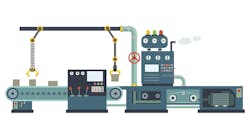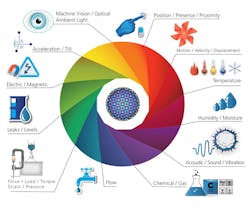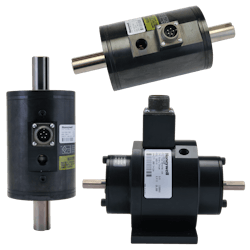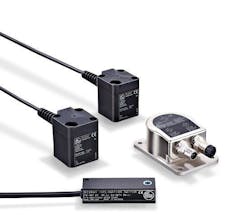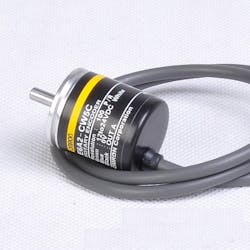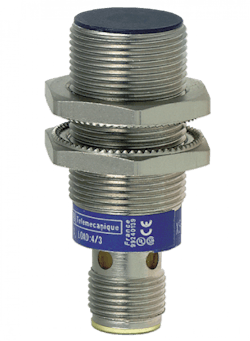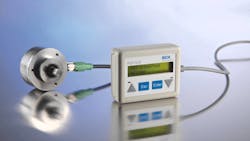The advances of smart motion systems will trickle down into several different markets. Smart motion systems are defined by their use of connected networks, advanced sensors, autonomous machinery, and computing power to improve efficiency and production. The motion-control sensor market is one such market that will have a massive expansion and industry growth potential as a result of the smart-motion system growth.
The motion sensor market is crucial to measuring of not only ambient conditions but also operating conditions of products. This helps to track the maintenance and operation of motion systems. (Image courtesy of Postscapes)
Future Market Outlook
According to a recent market report from Research and Markets (http://bit.ly/2w9ujKh), the motion-control sensor market will grow at a compound annual growth rate of 4.24% from 2017 to 2021. A similar report from Zion Market Research estimates that the global motion sensor market will reach $8.17 billion by 2022.
The reason for this trend is the development of industrial Internet of Things (IIoT) systems. The sensors and motion-control products work together to introduce smart motion systems on the factory floor. Many sensors are now advanced enough to capture data at the edge or at the device level and transmit said data into the cloud. This provides a greater flexibility for use onsite. Wireless sensors are also being used to send data long range.
Motion control relies on automation, and advances in sensing controls provide enhanced automation. Sensors allow systems to require minimal human intervention due to safety features and higher accuracy readings.
According to Raghav Bharadwaj Shivaswamy, an industry expert at Technavio for research on automation, “in a structured motion-control system, there can be a minimum of one sensor and maximum of six sensors, which can be installed to measure various aspects such as speed, torque, objects, displacement, and position… The majority of the revenue is from position and displacement sensors as these sensors are mainly used for the movement of goods and services in the plant premises through conveyors or other means.”
The report lists the major sensor groups and industries that will benefit over the next five years.
- Major Group of Sensors
- Position and displacement sensors
- Proximity sensors
- Speed sensors
- Torque sensors
- Major Industries
- Robotics
- Semiconductor machinery
- Material handling
- Packaging and labeling machinery
Key Products from Motion-Sensor Companies
The report from Research and Markets lists the key players in the motion-control sensor market and some of the highlighted products that are examples of what’s to come in future advancements. According to the report, the top five companies in the motion-control sensor market are Honeywell, ifm, Omron, Schneider Electric, and Sick.
Honeywell Model 1800 Series
The model 1800 series from Honeywell is an enhanced accuracy rotary torque sensor. The sensor has a torque range of 100 lb.-in. to 100,000 lb.-in. and non-linearity percentage of .05%. It also has an extended speed range up to 27,000 revolutions per minute. This line of sensors is ideal for test installations that have a long-run term durability testing. The non-contact nature of the signal transfer helps eliminate the need for constant maintenance. The high overload protection with high signal output helps protect the sensor from damage and the carrier frequency excitation provides increased signal and noise immunity.
ifm JN2100
The JN2100 sensor from ifm is an inclination sensor. The sensor is used for 2-axis position detection and zero-point leveling for mobile applications. The operating voltage range is 9.2 to 30 volts. The sensor can operate in harsh environments and is IP 65, 67, 68, and 69K rated. It can operate in temperatures ranging from -40°C to 85°C. One of the ideal situations to use it is in a wind generation tower. The structural vibration of a wind tower is typically measured using vibration sensors and displacement sensors. The JN2100 can be used in conjunction with a 3-axis vibration sensor to monitor the structure of the wind tower.
Omron E6A2C
The incremental rotary encoder E6A2-C from Omron offers consistent positioning for rotating precision jobs. Incremental encoders output a pulse string in accordance to the rotational displacement of an axis. The number of rotations is in direct relation to number of pulses from the encoder. The incremental encoders are beneficial for engineers that need to keep an accurate track of mechanical displacement. This can help with maintenance prevention and tracking of work output. The E6A2C series has a power supply voltage ranging from 5 to 24 volts. The output phases range from phase A, B, and Z. The resolution goes up to 500 pulse per rotation. The encoder series can operate in temperatures of -25°C to 80°C and are shock- and vibration-resistant.
Schneider Electric OsiSense XS and XT
The OsiSense XS and XT sensors from Schneider Electric are inductive and capacitive proximity sensors for non-contact sensing respectively. These sensors are well suited for assembly machine, robotic, machine tools, packaging, materials handling, and conveying applications. They can be used in the food and beverage industry as well as the automotive industry. The sensors have an IP 69K rating and comply with international standards.
SICK DFS60
The SICK DFS 60 is a programmable encoder. It is designed for sophisticated applications such as conveying machines for packaging and product distribution. The high resolution is up to 16 bits and can be mounted via a servo flange, face mount, blind, or through a hollow shaft. The benefits of this motor are that can be programmed via an Ethernet connection or with the handheld programmer from SICK. The small motor helps reduce storage costs and downtime. The high enclosure rating guarantees permanent and safe operation. The motor is temperature resistant, up to 100°C and is shock- and vibration-resistant.
